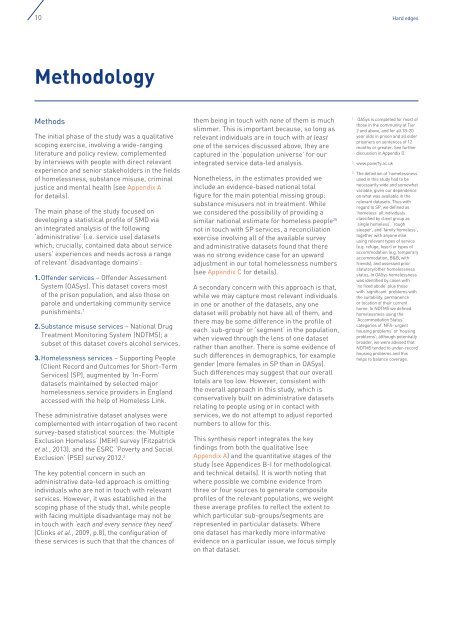Hard_Edges_Mapping_SMD_FINAL_VERSION_Web
Hard_Edges_Mapping_SMD_FINAL_VERSION_Web
Hard_Edges_Mapping_SMD_FINAL_VERSION_Web
Create successful ePaper yourself
Turn your PDF publications into a flip-book with our unique Google optimized e-Paper software.
10 <strong>Hard</strong> edges<br />
Methodology<br />
Methods<br />
The initial phase of the study was a qualitative<br />
scoping exercise, involving a wide-ranging<br />
literature and policy review, complemented<br />
by interviews with people with direct relevant<br />
experience and senior stakeholders in the fields<br />
of homelessness, substance misuse, criminal<br />
justice and mental health (see Appendix A<br />
for details).<br />
The main phase of the study focused on<br />
developing a statistical profile of <strong>SMD</strong> via<br />
an integrated analysis of the following<br />
‘administrative’ (i.e. service use) datasets<br />
which, crucially, contained data about service<br />
users’ experiences and needs across a range<br />
of relevant ‘disadvantage domains’:<br />
1. Offender services – Offender Assessment<br />
System (OASys). This dataset covers most<br />
of the prison population, and also those on<br />
parole and undertaking community service<br />
punishments. 1<br />
2. Substance misuse services – National Drug<br />
Treatment Monitoring System (NDTMS); a<br />
subset of this dataset covers alcohol services.<br />
3. Homelessness services – Supporting People<br />
(Client Record and Outcomes for Short-Term<br />
Services) (SP), augmented by ‘In-Form’<br />
datasets maintained by selected major<br />
homelessness service providers in England<br />
accessed with the help of Homeless Link.<br />
These administrative dataset analyses were<br />
complemented with interrogation of two recent<br />
survey-based statistical sources: the ‘Multiple<br />
Exclusion Homeless’ (MEH) survey (Fitzpatrick<br />
et al., 2013), and the ESRC ‘Poverty and Social<br />
Exclusion’ (PSE) survey 2012. 2<br />
The key potential concern in such an<br />
administrative data-led approach is omitting<br />
individuals who are not in touch with relevant<br />
services. However, it was established in the<br />
scoping phase of the study that, while people<br />
with facing multiple disadvantage may not be<br />
in touch with ‘each and every service they need’<br />
(Clinks et al., 2009, p.8), the configuration of<br />
these services is such that that the chances of<br />
them being in touch with none of them is much<br />
slimmer. This is important because, so long as<br />
relevant individuals are in touch with at least<br />
one of the services discussed above, they are<br />
captured in the ‘population universe’ for our<br />
integrated service data-led analysis.<br />
Nonetheless, in the estimates provided we<br />
include an evidence-based national total<br />
figure for the main potential missing group:<br />
substance misusers not in treatment. While<br />
we considered the possibility of providing a<br />
similar national estimate for homeless people 25<br />
not in touch with SP services, a reconciliation<br />
exercise involving all of the available survey<br />
and administrative datasets found that there<br />
was no strong evidence case for an upward<br />
adjustment in our total homelessness numbers<br />
(see Appendix C for details).<br />
A secondary concern with this approach is that,<br />
while we may capture most relevant individuals<br />
in one or another of the datasets, any one<br />
dataset will probably not have all of them, and<br />
there may be some difference in the profile of<br />
each ‘sub-group’ or ‘segment’ in the population,<br />
when viewed through the lens of one dataset<br />
rather than another. There is some evidence of<br />
such differences in demographics, for example<br />
gender (more females in SP than in OASys).<br />
Such differences may suggest that our overall<br />
totals are too low. However, consistent with<br />
the overall approach in this study, which is<br />
conservatively built on administrative datasets<br />
relating to people using or in contact with<br />
services, we do not attempt to adjust reported<br />
numbers to allow for this.<br />
This synthesis report integrates the key<br />
findings from both the qualitative (see<br />
Appendix A) and the quantitative stages of the<br />
study (see Appendices B-I for methodological<br />
and technical details). It is worth noting that<br />
where possible we combine evidence from<br />
three or four sources to generate composite<br />
profiles of the relevant populations, we weight<br />
these average profiles to reflect the extent to<br />
which particular sub-groups/segments are<br />
represented in particular datasets. Where<br />
one dataset has markedly more informative<br />
evidence on a particular issue, we focus simply<br />
on that dataset.<br />
1<br />
OASys is completed for most of<br />
those in the community at Tier<br />
2 and above, and for all 18–20<br />
year olds in prison and all older<br />
prisoners on sentences of 12<br />
months or greater. See further<br />
discussion in Appendix D.<br />
2<br />
www.poverty.ac.uk<br />
3<br />
The definition of ‘homelessness’<br />
used in this study had to be<br />
necessarily wide and somewhat<br />
variable, given our dependence<br />
on what was available in the<br />
relevant datasets. Thus with<br />
regard to SP, we defined as<br />
‘homeless’ all individuals<br />
classified by client group as<br />
‘single homeless’, ‘rough<br />
sleeper’, and ‘family homeless’,<br />
together with anyone else<br />
using relevant types of service<br />
(e.g. refuge, foyer) or types of<br />
accommodation (e.g. temporary<br />
accommodation, B&B, with<br />
friends), and assessed prior<br />
statutory/other homelessness<br />
status, In OASys homelessness<br />
was identified by cases with<br />
‘no fixed abode’ plus those<br />
with ‘significant’ problems with<br />
the suitability, permanence<br />
or location of their current<br />
home. In NDTMS we defined<br />
homelessness using the<br />
‘Accommodation Status’<br />
categories of ‘NFA- urgent<br />
housing problems’ or ‘housing<br />
problems’; although potentially<br />
broader, we were advised that<br />
NDTMS tended to under-record<br />
housing problems and this<br />
helps to balance coverage.


